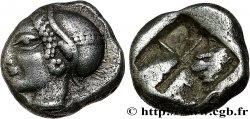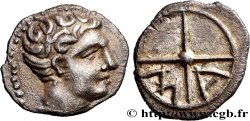bga_177695 - MASSALIA - MARSEILLE Trois quarts de litra du type du trésor d’Auriol à la tête de bélier
Not available.
Item sold on our e-shop (2010)
Price : 250.00 €
Item sold on our e-shop (2010)
Price : 250.00 €
Type : Trois quarts de litra du type du trésor d’Auriol à la tête de bélier
Date: c. 480-470 AC.
Mint name / Town : Marseille (13)
Metal : silver
Diameter : 7,8 mm
Weight : 0,71 g.
Rarity : R2
Coments on the condition:
Agréable monnaie homogène, complète au droit et au revers. Patine de collection ancienne
Catalogue references :
Obverse
Obverse legend : ANÉPIGRAPHE.
Obverse description : Rhyton, tête de bélier à gauche, avec la corne enroulée ; le col perlé.
Reverse
Reverse legend : ANÉPIGRAPHE.
Reverse description : Carré creux irrégulier.
Commentary
Pour ce type, la BN conserve les n° 386 à 443, avec trois types de carré creux. Sans distinction, les poids varient de 0,23 gramme à 1,05 grammes. L'exemplaire illustré dans le LA TOUR II pèse 0,89 gramme. Ce type correspond en fait aux n° 386 à 395, par rapport au poids. Ce type existe aussi avec la tête à droite (BN. 377-385) mais avec une croix perlée dans un carré creux.








 Report a mistake
Report a mistake Print the page
Print the page Share my selection
Share my selection Ask a question
Ask a question Consign / sell
Consign / sell
 Full data
Full data



